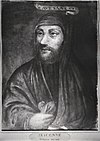|
Al-Nijat
Al-Nijat min al-Qarq fi Bahr al-Zalalaat (Arabic: النجاة من الغرق في بحر الضلالات, transl. salvation from falling into the sea of misguidances) known as Al-Nijat is one of the most famous philosophical works of the Persian philosopher Avicenna (ibn Sīnā, 980-1037). The general theme of the book is philosophy and includes topics in the fields of logic, physics, mathematics and theology.[1] Epistemology and approachThe book "Al-Nijat min al-Qarq fi Bahr al-Zalalaat" written in Arabic and includes a course of theoretical philosophy (logic, physics, mathematics and theology). According to some researchers, "Al-Nijat" is a selection from The Book of Healing. The great similarity of the book of "Al-Nijat" to The Book of Healing in the order of the chapters and in the content is the reason for these opinions. Some points can be considered about this view:[2][3][4]
The headings are arranged this way:[1]
ContentLogicThe logic section of the book "Al-Nijat min al-Qarq fi Bahr al-Zalalaat" is very similar in definitions and titles to the logic section of The Book of Healing, and from this point of view "Al-Nijat" is an excerpt from it. But the ease and clarity of the definitions, the expression based on division, the avoidance of prolongation of the word, and the omission and displacement of some issues, have made "Al-Nijat" in these respects both superior to the extensive book of healing and more valuable than the excerpt book of "Oyoun al-Hikma" of Avicenna.[2] Some of the topics in the logic section of the book are:[5][6]
PhysicsAvicenna's purpose in writing the physics sections was to establish a scientific style for future generations, but he did not necessarily include the latest scientific material in it. Although Avicenna was a follower of Aristotle in meteorology and he himself acknowledged it, he did not follow Aristotle's views in cases where a new and appropriate theory seemed to him or he himself reached a different conclusion. Avicenna on various aspects of geophysics, meteorology and atmospheric effects, including the formation of mountains, groundwater, earthquakes, mining, clouds, rain, water vapor, dew, snow, hail, halo, sunbow, wind (origin, types, quantity, temperature, power, rainfall, effects, duration, direction, etc.), thunder, lightning, comet and meteor.[7] Some of the topics of the physics section are:[8]
MathematicsIn mathematics, Avicenna studied and analyzed the principles of Euclid, but did not elaborate and stated only what was necessary to understand the theorems and prove them in order to acquaint the learner with the basics of geometry as soon as possible. Avicenna has also dedicated section 7 of the book of "Al-Nijat" to geometry. Avicenna openly considered music to be mathematics. He has also dealt with shapes, their properties and performances. Avicenna's theories on mathematics have not yet been fully explored, but Karl Lukuc has examined part of his mathematics (flat geometry) in his book "Avicenna as a Mathematician".[7] Some of the topics in mathematics section are:[9]
TheologyAvicenna begins the issue of knowing existence from the very concept of "being and existence". According to him, existence and existent are the most obvious concepts and no explanation can be given about existence or existent except their name. "Existence can not be described except by its name, it is the first source of any description, so there is not a description for it, but its form is immediately placed in the mind (ego)."[10] In Avicenna's ontology, not all beings have the same concept of existence, but some are more deserving and worthy in this sense than others. Thus beings are in order. Avicenna says in this regard:
ExplanationsThe book Al-Nijat has several explanations such as: PublicationThe book Al-Nijat min al-Qarq fi Bahr al-Zalalaat, first published in Cairo by Mohyeddin Sabori al-Kordi in 1913 and secondly in 1938.[18] Also Al-Nijat has been edited by Mohammad Taqi Danesh Pajouh in 1985, published by University of Tehran Press in Iran.[19] This version has an introduction in Persian written by Danesh Pajouh which describes subjects in detail. Then there are pictures of the Arabic manuscript of the book, then the text of book in Arabic.[20][21][22] The "Theology" section was translated into English by Nematullah Karamollahi and published in Rome in 1926. The English translation of the "Ego" (psychology) section was also published by Fazlur Rahman Malik in his book "Avicenna's Psychology", first published in 1952 and secondly in 1981 in London.[7] See also
References
External links |
